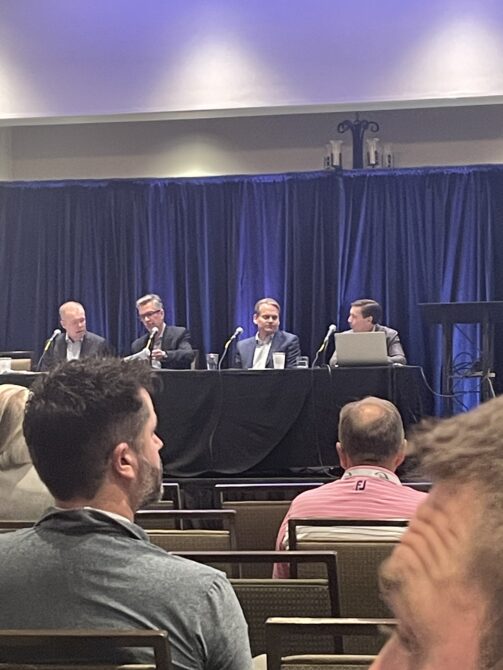
 It is often said that learning occurs through listening rather than talking.
It is often said that learning occurs through listening rather than talking.
Such was readily apparent in attending the presentations at a recent conference by John Brown, CEO of GreatLIFE Golf Management; Jay Karen, Executive Director of the National Golf Course Owners Association; Don Rea, Vice President of the PGA of America and owner of Augusta Ranch; Jim Hinckley Century Golf Partners Founder & CEO; Tim Schantz, President and Chief Operating Officer of Troon; and Steve Skinner, Chief Executive Officer of Kemper Sports. They are among the most sage, having their fingers on the pulse of the golf industry.
Their thoughts provide great insight. The consensus is shared below for your reflection and hopefully benefit.
————————-
A decade ago or more, there was a lack of serious capital investing in the golf business, with only two or three funding sources available. Then, the golf business was built on the back of PGA Professionals who worked long hours. Private equity was attracted to apartments offering a capitalization rate of 6 to 8 vs. the golf industry’s rate ranging from 10 to 12.[1]
Today, those cap rates have reversed with the increasing vacancy in office buildings and commercial space now perceived as an investment risk. In contrast, with its limited supply of courses with 13,170 18-hole equivalents, golf has become attractive as buying is more cost-effective with far less risk than building.
Six private equity firms are chasing deals in golf currently. While the valuation of a hotel can be determined by occupancy, the metrics for the golf industry are membership subscriptions, as customer acquisition costs are perceived as low based on greater industry demand resulting from the Pandemic.
The demand for golf at resorts is “off the charts” and to a slightly lesser extent at private clubs. The “arms race” to attract new members is based on renovating clubhouses that provide a broad breadth of refined services and heightened experiences. With the increase in initiation fees and annual dues, customers’ expectations have increased in relationship to the higher fees. Guests at resorts and members at private clubs are emphasizing services over goods.
New private courses will feature uber-luxury experiences, such as CapRock Ranch, Congaree Golf Club, and Jeule Ranch.
While municipalities are unlikely to build any new courses, it was felt that they would remain in a very strong position for the next ten years in heavily populated metropolitan areas where some may ultimately close due to the demand for intra-city affordable housing.
The group thought the weakness in golf would first be seen in low-end private clubs and golf courses beyond large cities that lack pricing power.
However, that is not the case now. All expressed that they believe a “longer runway” exists for the continued sustained demand for many reasons.
Golf is now perceived as “cool. “Youth participation via the PGA Junior League and Youth on Course is soaring. The mass mediate marketing of GolfNow also has had a positive impact, and off-course participation through its gamification (Top Golf, Drive Shack, Big Shot, Popstroke, and the burgeoning screen golf (which is a great teaching venue) is creating a runway for green grass facilities. They cited that 22% of off-course participants are interested in green grass golf, while only 4% of all non-golfers have a similar interest.
The stated that the traditional golf model is “dead.” Relaxed dress standards, music, and the emergence of off-course venues (2 ten years ago to over 500 in the United States in 2022) comes with the potential risk of alienating golf’s core base. They are remiss that no organized industry program can convert off-course to on-course players.
As wise business operators, they also shared some cautions.
People’s expectations of what they are willing to give to a workplace have changed based on an emphasis on personal priorities vs dedication to a corporation. Minimum wage increases through legislative efforts could create an expense drag as the cost structure to operate facilities has dramatically accelerated since 2019. As a result, technology will be used to create personal service via cell phone apps, facilitating the reduction of staff workers.
Not surprisingly, in the public sector, barter used by golf software companies remains a thorn in the side of golf course owners in which the thought leaders advocated controlling your inventory, customer communication, and customer database.
A developing issue beyond barter is that golf software companies are now mandating the use of a credit card processor with which they have integrated. From this integration, software companies are now realizing incremental revenue from each credit card transaction at the expense of the golf course owner.
Standardization of credit card rates is sought, as well as realizing that the golf course industry is the only one with a perishable commodity where the customer is not held fully accountable for the tee times they book. Credit card guarantees should now be mandated with 24-48 hour cancellation policies established.
————————-
What does the future hold? Hopefully, the insights provided by these thought leaders will ripple throughout the industry, guiding all golf owners to continue financial success.
[1] Note that a capitalization rate is a ratio that measures the rate of return on a real estate investment property. A 6 to 8 percent cap rate is considered low and is generally associated with less risky investments. On the other hand, a cap rate of 10 to 12 percent is considered high and is usually associated with more risky investments.


Johnathan D Hart
Golf has changed quite a bit in the last few decades. It seemingly lost the luster of a gentleman’s sport and has now turned to younger player who have no real respect for the honor in the game and alcohol is as important as anything about the game. I’ve spent 50+ years in golf management and golf course ownership and fail to see anything much celebrating the nine core values of golf. Big management companies are taking far too much time to train staff, because, …… well it should be obvious.
JJ, keep up your good work.